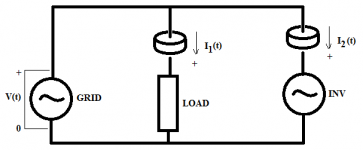OK, but I was wondering about the part where you said that the voltage and current waveforms were out of phase. The output of a grid tied PV inverter is very close to power factor 1.0.
It all comes down to the sign assignments of what we call positive current at a point we measure it. In the following example, I would say the power factor of the inverter is -1.0, rather than +1.0. The resistive load by contrast has +1.0 as its power factor.
Consider the following diagram:

The voltage is the function of time V(t), is established by the grid. We connect the load, that draws power from the grid. The current that the load draws, is measured by the sensor marked I1(t). We also connect an inverter source, and include a sensor marked I2(t). We set up the sensors such that they both assign current as positive when it flows in the direction indicated. The + sign on the voltage sensor indicates that voltage is positive, when the voltage at that point is higher than the voltage at the point marked 0. We could reverse the sensors if we desired, which might seem more logical for an inverter, but to make my point, I'm giving both sensors the same orientation and sign convention.
V(t) is given by the following equation, where U and w are constants:
V(t) = U*cos(w*t)
Given a linear load with unity power factor, and resistance R, the current through the load would therefore be:
I1(t) = U/R * cos(w*t)
The waveform V(t) and I1(t) are both in-phase with each other. The only difference is that U gets reduced by the factor of R. Graph them on the same plot, and they both start at the maximum value, then coast to zero, then fall to the minimum value, rise back to zero, and then rise back to the maximum value. The two waveforms are in phase
Moving onto I2(t). Due to being a source rather than a load, it will supply power to the grid, rather than drawing power from the grid. This means that when voltage is positive, the current from the inverter flows upward on this diagram, "uphill" due to being given energy by the inverter source. This means that when voltage is positive, the sensor I2(t) measures a negative value. The opposite happens during the negative half of the cycle. When voltage is negative, the sensor I2(t) measures a positive value. The amplitude of the inverter's current waveform is a constant we'll call J.
Current I2(t) is therefore, the function:
I2(t) = -J*cos(w*t)
It is the same wave shape, but it is the negative of what current feeding a load would be.
Alternatively, we can write this with a phase shift term, rather than a negation:
I2(t) = J*cos(w*t + 180 deg)
This is why it has a 180 degree phase shift. Current I2(t) is 180 degrees out of phase with current I1(t), due to the fact that we set up our sensors to make I1(t) positive when V(t) is positive. The power factor is the cosine of this phase shift. The cosine of 180 degrees is -1.
A common misconception about power factor, is the use of the negative sign to indicate the property of a leading vs lagging. The sign of the power factor has nothing to do with this property. The sign of the phase offset angle is what really indicates this. Power factor = cosine of this angle, and cosine ignores the angle's sign completely due to the symmetry of the function. You need an angle greater than 90 degrees to get cosine to become negative. A negative power factor means that the real power component is negative. Given a current sensor set up to meter a load as positive, a negative real power means that you are measuring a source rather than a load


